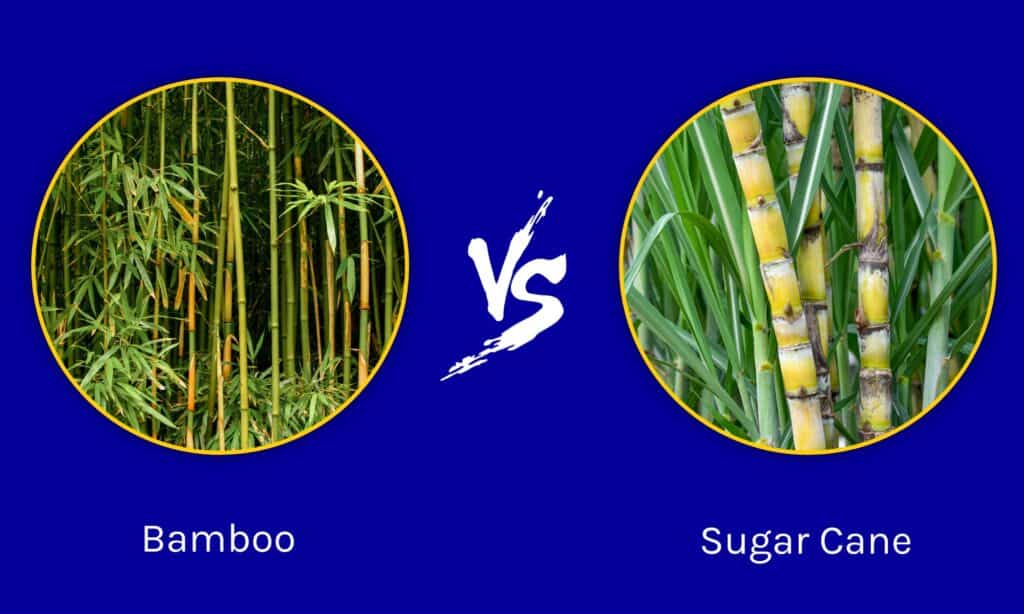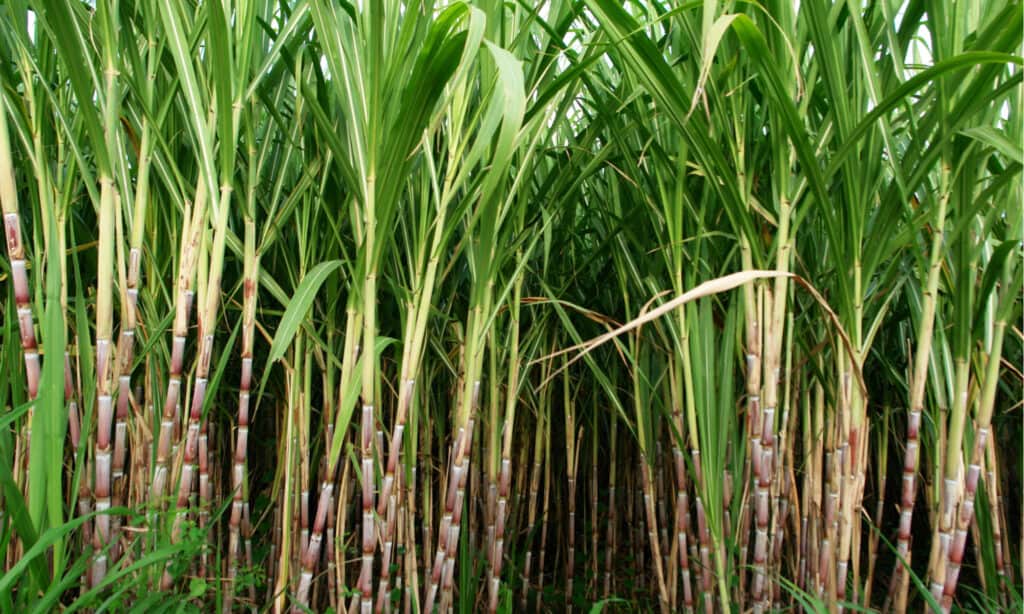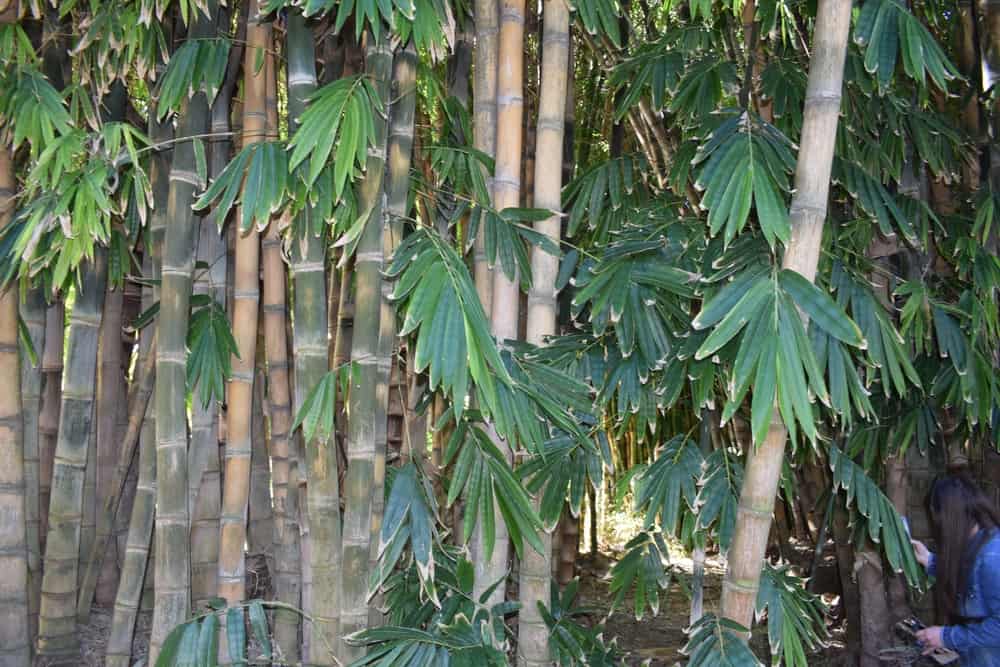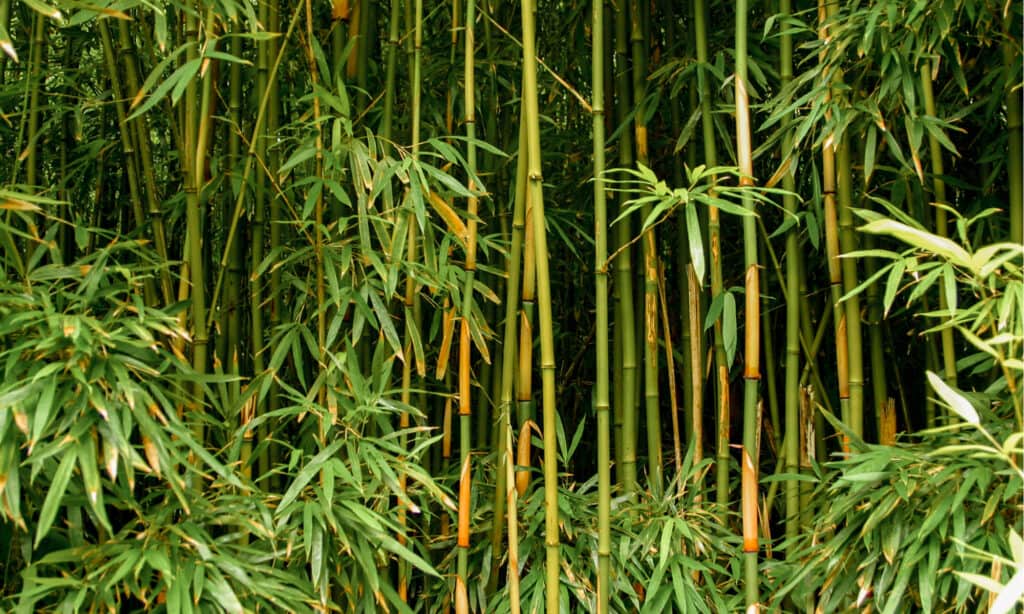While they may look similar upon first glance, there are many differences between bamboo vs sugar cane. Whether you would like to grow either of these two plants in your own home, or simply have an invested interest in them, we are going to discuss everything you need to know about both bamboo and sugar cane, including how they compare to one another.
In this article, we will go over what bamboo and sugarcane look like in detail so that you can learn how to tell them apart. In addition, we will touch upon what both of these plants are typically used for. Finally, we will go over the locations that both bamboo and sugarcane grow best in, including how to care for them properly. Let’s get started now!
Comparing Bamboo vs Sugar Cane

| Bamboo | Sugar Cane | |
|---|---|---|
| Classification | Poaceae bambusoideae | Saccharum officinarum |
| Description | Thin, woody trunks that end in long and delicate leaves. Can grow up to 90-100 feet tall, depending on the species, of which there are roughly 1200! Comes in a variety of colors, including green, gray, black, and red. Stems or trunks are typically hollow, with visible rings around the outside to show their growth. | Grows in clusters of woody stalks or trunks, terminating in long, flowing leaves. Averages 8-25 feet in height, and has a flowery tassel when it reaches maturity. Has segmented portions with distinct rings, and the leaves are greener than the stalk. |
| Uses | Dozens of uses, including furniture, paper crafts, culinary applications, home building, accessories, home goods, decoration, and more. Also utilized medicinally in many cultures, and you can make musical instruments too! | Primarily used to produce sugar for a number of culinary uses, but also grown as a biofuel. The plant is also used in thatching applications and as food for livestock such as cows and goats. |
| Hardiness Zones | 5-10 | 9-10 |
| Water and Light Needs | Depends on the species, but often needs at least 5 hours of bright, indirect light per day. Needs an inch or two of water per week, but don’t let the roots sit in water. | Needs full and direct sunlight each and every single day to produce well. Also enjoys moist environments, so water often. |
Key Differences Between Bamboo vs Sugar Cane

Bamboo grows much taller than sugar cane does, averaging anywhere from 50 to 90 feet, while sugar cane only grows 8 to 25 feet on average.
©margouillat photo/Shutterstock.com
There are a number of key differences between bamboo and sugar cane. For example, bamboo is a member of the Poaceae genus, while sugar cane is a member of the Saccharum genus. Additionally, bamboo grows much taller than sugar cane does, and comes in more colors, depending on the bamboo variety. Finally, sugar cane grows in fewer hardiness zones compared to the versatile bamboo.
Let’s discuss all these differences in more detail now.
Bamboo vs Sugar Cane: Classification
While they may look similar upon first glance, bamboo and sugar cane belong to different plant genuses. However, they both belong to the grass family of plants, which likely explains their physical similarities. You can easily tell bamboo apart from sugar cane based on their genus names: Poaceae bambusoideae and Saccharum officinarum, respectively.
Bamboo vs Sugar Cane: Description

Sugar cane grows in unique clusters of stalks, while bamboo grows in a more singular fashion.
©Furiarossa/Shutterstock.com
Both sugar cane and bamboo grow on narrow stalks or trunks, with evenly dispersed rings showing their age. However, there are many more differences than similarities in the physical appearances of these plants. For example, bamboo grows much taller than sugar cane does, averaging anywhere from 50 to 90 feet, while sugar cane only grows 8 to 25 feet on average.
You can also find bamboo in more colors compared to sugar cane, depending on the bamboo variety. Additionally, sugar cane grows in unique clusters of stalks, while bamboo grows in a more singular fashion. Finally, the leaves of sugar cane are much larger compared to the leaves found on bamboo. Sugar cane also gets a tasseled flower at the end of its stock when it reaches maturity, something that bamboo does not share.
Bamboo vs Sugar Cane: Uses

Bamboo has countless uses, including home and furniture manufacturing, while sugar cane is primarily used in a culinary fashion.
©Yatra4289/Shutterstock.com
You likely already know a few uses for both bamboo and sugarcane, and this is just another difference separating these two plants. For example, bamboo has countless uses, including home and furniture manufacturing, while sugar cane is primarily used in a culinary fashion. Sugar cane is also used as a biofuel, while bamboo is also used in culinary applications.
Bamboo vs Sugar Cane: Hardiness Zones
Depending on the bamboo variety, there is a key difference in the preferred hardiness zones of sugar cane and bamboo. For example, sugar cane only grows best in hardiness zones 9 and 10, while bamboo grows anywhere throughout hardiness zones 5 through 10, depending on the variety. Some bamboo can handle colder temperatures than others, though sugar cane requires plenty of warm weather and sunlight in order to survive.
Bamboo vs Sugar Cane: Water and Light Needs

Sugar cane only grows best in hardiness zones 9 and 10, while bamboo grows anywhere throughout hardiness zones 5 through 10, depending on the variety.
©Eric Patterson/Shutterstock.com
Speaking of needing sunlight in order to survive, there are some distinct differences in the care requirements of both bamboo and sugar cane. For example, sugar cane needs full sun throughout the day in order to produce adequate sugar crops, while bamboo can grow in direct sunlight or partial shade.
While it depends on the variety, there are some differences in the water needs of both bamboo and sugar cane as well. Sugar cane prefers a moist environment, often grown in humid regions, while bamboo prefers that its roots do not sit in water. This is an important difference, especially if you plan on growing either of these plants in your own backyard!
The photo featured at the top of this post is © Yatra4289/Shutterstock.com
Thank you for reading! Have some feedback for us? Contact the AZ Animals editorial team.







